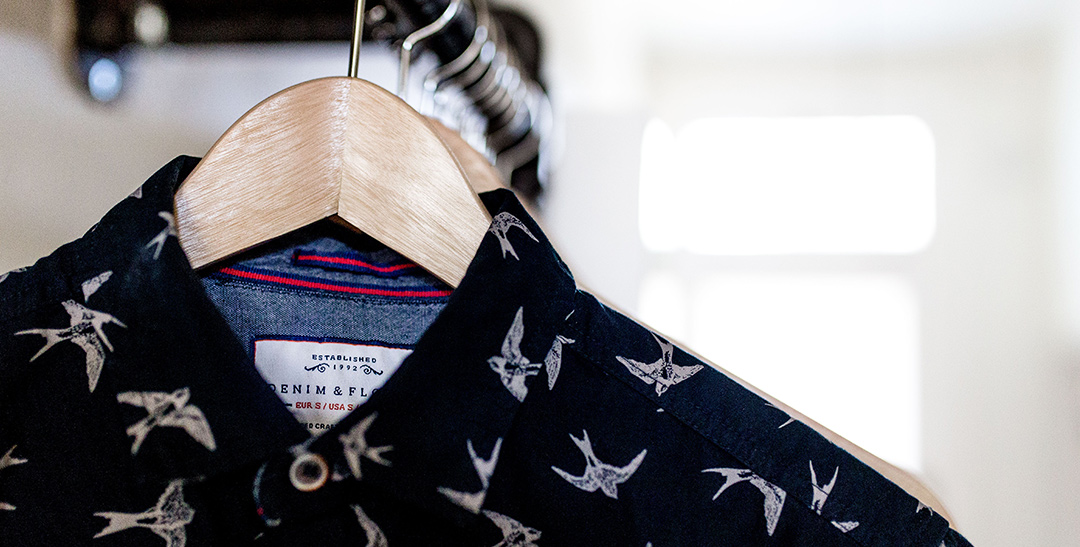You are reading the final part of the 7-part series on How to Skilfully Declutter Your Home Once and for All. If you are new to this series, then consider starting from Part 1.
Imagine you have a personal stylist. On a daily basis, they carefully select beautiful outfits for you, keep your wardrobe pretty tidy, and offer all of their services for free.
A pretty tempting deal, isn’t it?
Well, that’s what I ended up creating for myself a couple of years ago when I decided to deliberately apply 20 years of professional experience of designing digital interfaces to my wardrobe. It required me to organise my closet in a whole new way which I call Need-Centric Organisation.
Actually, the whole experiment has been so successful that I’d never return to the previous—and more common—way of organising a clothes cupboard.
Gains of Need-Centric Organisation
What follows are the three benefits that you’re likely to experience when you’ll organise your wardrobe based on the need-centric approach.
1. No more thinking about what to wear
Every time you make a decision—for instance about what to wear in the morning—you’re using your mental resources; your willpower. Research suggests we have finite mental energy with which to make decisions, and so I prefer to use that energy to make more important choices (such as, who should help me pick my new Christmas jumper: Kan or Kes).

The approach illustrated in this article will help you overcome this problem: you won’t have to think about what to wear every morning. With your eyes closed, you’ll be able to pick a shirt and a pair of trousers, for example, and they will perfectly match.
Interestingly, we won’t be the only ones to be adapting to the lifestyle changes like this. Obama, Mark Zuckerberg, and many others have simplified their closets in an effort to curb wasting their willpower.
“I’m trying to pare down decisions. I don’t want to make decisions about what I’m eating or wearing. Because I have too many other decisions to make.” – Obama
“I really want to clear my life to make it so that I have to make as few decisions as possible about anything except how to best serve this community” – Zuckerberg
2. Get ready much, much faster
For the vast majority of us, our decisions are not as big as those famous people. But it would be hard to argue against the fact that many of us have awfully busy mornings; we try to cram-in a myriad of activities before we make our way into work.
The approach presented in this article will enable you to pick your clothes pretty quickly, and without having to solve the what-will-match-what puzzle; consequently, you’ll get ready much, much faster.
Additionally, your wardrobe will only contain the clothes that you will genuinely love so regardless of what you’ll wear it will make you feel confident and joyful.
3. Save lots of money
“I’m spending way more on my clothes shopping!” Does this thought ever cross your mind? If so, then this ‘shop’ has the right product for you!
The principles outlined in this article will help you design your closet based on all your needs. And since the majority of your physical and—more importantly—emotional needs will be satisfied, your shopping for garments, and thus corresponding expenses, will be likely to reduce significantly.
So, as you heard, the strategy will not only give you a clean wardrobe, but it’ll also make you efficient and help save your cash.
In fact, for me, the benefits were so pronounced that I felt compelled to apply the philosophy to nearly all areas of my life including professional priorities, fitness, finances, and even relationships. Actually, later in this article I’ll offer a bit more information on each of these aspects, but for now it suffices to say that it’s been genuinely life-changing!
The strategy: the end of a messy closet
The strategy presented in this article aims to help you completely declutter your wardrobe in three stages. First, you’ll make a list of all the clothes extrapolated from your goals and motivations. Then in the second stage, you’ll remove all the clutter systematically based on the three-piles approach. And lastly, you’ll set up your wardrobe with the essential pieces of clothing.
But isn’t this a lot of work?
Probably not, and please don’t let the length of this article intimidate you.
For me, it took just 4 hours for the bulk of work. Of course, this time will vary depending on the total amount of clothes, or the number of people you’ll consider, for example. But either way, I’m pretty confident that you’ll be glad to have made this relatively small investment of time in exchange for several benefits the process will yield for years to come.
The purpose of this article is to provide you with a practical example of the complete strategy that is described in the previous articles of this series. Therefore, I’ve discounted the majority of minutiae. Please consider reading relevant articles so that you can learn more about a stage or a topic (I’ll certainly try my best to point you in different directions with some well-placed links).
Stage 1: Elicit Needs
The first stage is the most crucial stage of the entire process, as you’ll build a map that will help you navigate through the intricate world of effective decluttering.
1. Why understanding goals matters very much indeed
If you simply empty your wardrobe, chuck away a couple of pieces of clothing, fold the rest neatly and put them back into the closet, then you’re most likely refraining from taking the benefits of a smartly organised wardrobe.
Instead, begin with assessing your goals and motivations. To do this, consider the following questions:
- In the context of my wardrobe, and considering my daily routine, what am I trying to accomplish?
- What brings me dissatisfaction with the current setup?
- How would the closet look if I had a magic wand?
Here’s a simplified version of my goals and motivations that helped declutter my clothes cupboard:
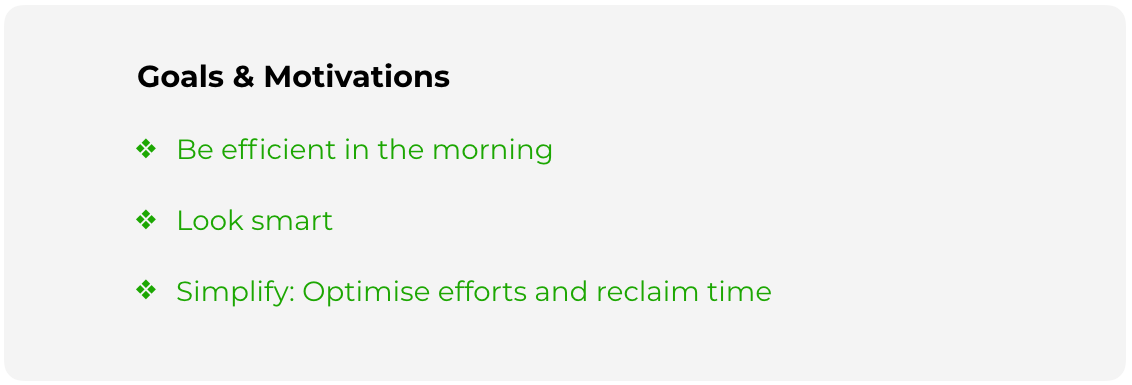
2. Good organisers carefully assess their needs
Needs in this context mean the actual pieces of clothes, all meticulously selected to help you meet your goals. Essentially, at the end of this step, you’ll have a list of all the clothes (and a few other optional, but relevant, items). And since this list is what you’ll use for the remainder of this strategy, it’s vital to get it right.
Start with the big picture
Using the above list, figure out your high-level needs. Think of them like overarching themes, each of them supporting one or more goals.
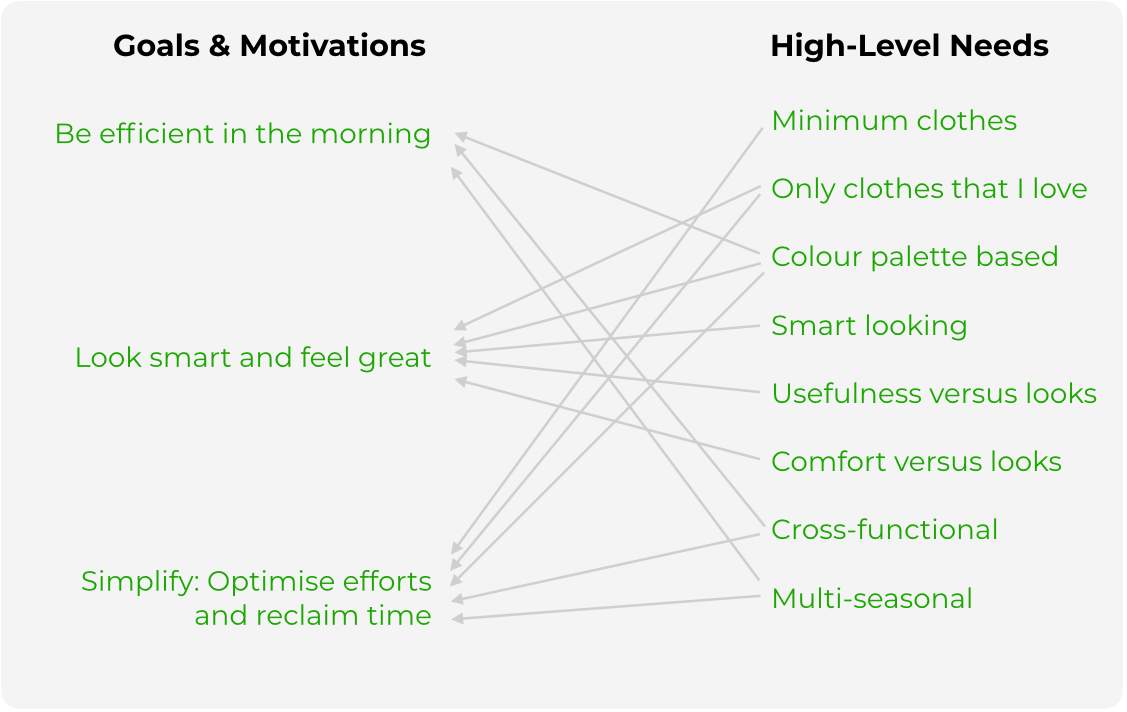
What follows are some of my thoughts that aided me to derive this list.
Colour palette based: Building a wardrobe with clothes that are based on a limited number of colours makes my clothes powerful. How? Well, my clothes become versatile: any shirt matches any pair of trousers seamlessly. This, certainly helps me get ready in the morning much faster. In the next section I’ll show you how you can create this colour palette.
Comfort versus looks: While I wanted to have clothes that looked smart, I wanted to ensure I picked clothes that were comfortable. No more suffocating super-skinny shirts or trousers that immobilises. In essence, I put ‘comfort’ first, then ‘looks’.
Usefulness versus looks: Similar to the above, I wanted to ensure that I prioritised the usefulness of a piece of clothing over its looks. After all, for most people, their rarely used clothes end up stealing most of the space in their closets, don’t they?
So, that lovely merino wool jumper (read blanket) that I could only wear five days a year, well, we broke up merrily. Now my favourite clothes can breathe freely.
Multi-seasonal: I live in London where the temperature, especially in winter, yo-yoes from cold to hot depending on if I’m indoor or outdoor.
Sweatshirts and other such clothes didn’t work. While walking out on roads they kept me warm, once inside they turned into a mobile-sauna due to central heating.
I needed clothes that worked across all seasons.
Cross-functional: One of my primary goals was to own the minimum number of garment pieces. I decided to select clothes that’d strike a balance between formal (work) and casual (non-work) so that I could use them in any setup.
Add in categories
Once you’ve established the overarching themes, the next step is to add in some categories. These categories, as suggested below, will inform the next step with necessary contextual information.
- Location-based categories: Most of us in nearly all cases need different clothes at work and on holidays. The idea is to list all of those potential locations.
- Type-based categories: Think of this as general categories based on types of stuff. Jackets, undergarments, or even accessories (if that’s what you keep inside your closet) are good categorical candidates for this category. Actually, anything that can’t fit in the above categories will go in these buckets.

Consider a typical year and ensure you’ve captured all the key categories. Incidentally, during my evaluation, I also included shoes. Although I don’t keep them inside the wardrobe, later on it helps to pick one or two best pairs of shoes that’d match the majority of my clothes; after all, wearing smart clothes was one of my goals!
List actual items
This one’s easy. Under each category, jot down the actual items along with quantity for each item. See if you can keep the number to the minimum which will naturally help you keep the potential clutter away.
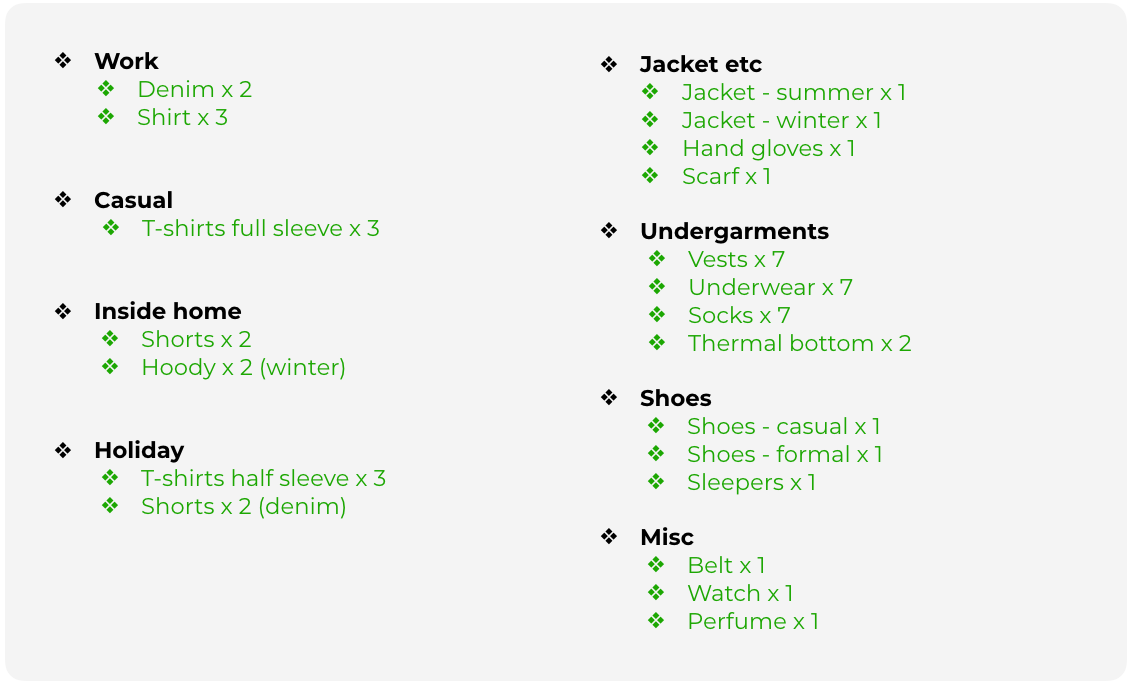
Define a colour palette
One of the most effective ways to keep the wardrobe with only essential clothes yet infusing the element of variety is to have all clothes based on a colour palette. Simply put, one piece of clothing matches with multiple of its counterparts. That’s to say any shirt matches any trousers and vice versa.
For me, blue, black, and white comprised the colour palette.

Once this is clarified, you assign the colours to the list above.
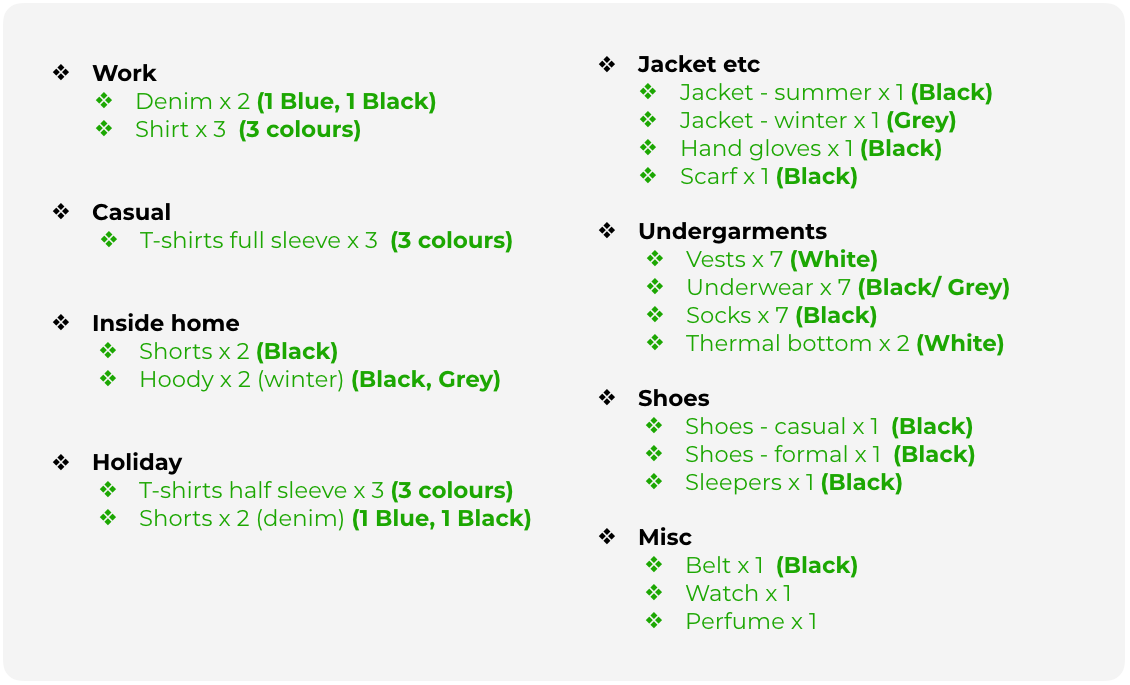
3. Finally, refine your needs
Tighten it up. Those three words pretty much sum up this step. 3 tops instead of 6. 2 pairs of shoes instead of 3. Considering the entire list, look at possibilities to lower the sum of all the items.
So far, then, you clarified your goals and defined the list of all the actual items for your future wardrobe.
Since this entire stage is the foundation of a clutter-free closet, it’s crucial for you to invest the time in making real effort. In other words, taking shortcuts will likely nullify your investment turning a clean wardrobe into chaos.
Stage 2: Eliminate Clutter
Let the fun begin! During this stage, you’ll remove all of the clutter within your closet in a whole new way—one that objectively considers all your needs.
1. Identify clutter: the 3-piles approach
Collect all the items inside (and outside) your wardrobe and put them on the floor. Then, considering each item, sort them into the following three heaps:
Pile A: Essentials: This mound should contain only those items that are part of the list of needs you created in the previous stage, and no more than 10% of all the things that you’re reviewing. Say your list has “Trousers – 2 pieces” and you manage to find those two trousers. Put a tick against that list item after placing those trousers in this pile.
Pile B: Inessentials: Your next 10%. All the optional things you can’t relinquish, go in here. Whether it’s “I just can’t give away the mug that grandpa left for me.”; or “I paid $300 for this pen so I ain’t giving it away!”; or “I don’t need these clothes now, but I’ll need them later in winter!”
Pile C: Clutter: Everything else left goes in here. If this heap doesn’t contain more or less 80% of all the items under review then consider moving some objects from Pile B into this heap.
Consider applying mind management tools as described in the previous article which will help you overcome emotional or monetary attachments and consequently enable you to remove the clutter more effectively.
2. Remove Clutter
This one’s simple: give away, sell, or chuck all the items contained within Pile C.
Stage 3: Establish Wardrobe
Now that nearly all the clutter is removed, you are left with the following three things:
- Your list of needs
- Pile A: Essentials
- Pile B: Inessentials
Let’s first start with the last item in this list.
1. How to stow away the inessentials
Pack all the stuff contained in Pile B and put it away.
Coupled with all the items in Pile B (Inessentials), I also decided to store away some clothes from Pile A (Essentials), namely my holiday clothes (predominantly all the summery stuff) which I didn’t need on a regular basis.
The primary idea is to put the majority of those items through a test of time. To see if you can live without them for the next three to six months. If you didn’t need those items during that time, classify those items as clutter and get rid of them altogether.
2. Spot gaps
At this point, you’re left with:
- Your list of needs
- Pile A: Essentials
Scan through the list of needs and identify any items that you don’t possess. That’s to say you need to pinpoint all those items in the list that haven’t yet received a tick.
3. Organise the essentials
Finally, organise all the essential items from Pile A.
4. Fill in the gaps the need-centric way
Once you’ve set up your wardrobe, you can source the missing items (that you identified during Step 2: Identify Gaps).
The previous article details how to execute this entire exercise effectively. Here’s a summary:
- Reflect on all your needs. Don’t cut corners
- Explore lots of options. Use the power of the web
- If in doubt, ask:
Do I love this? If there’s not a quick “Hell yeah!”, then it’s a no.
But, isn’t it boring to wear the same clothes again and again?
As I shared above, while Mark Zuckerberg and others alike don’t seem to mind wearing identical T-shirts daily, the vast majority of us favour variety. Hence the whole strategy accounts for this universal human need and offers you different kinds of clothes.
But, say, after six months you get bored of wearing those clothes that are based on your list of needs. What do you do then? You can’t just add more clothes to your wardrobe as that would go against the principles laid out in the strategy and will take you down to Clutterville!
Instead, consider changing the whole or part of the wardrobe. That’s to say, you can replace all or some items in your closet with new ones. For this, consider creating a new colour palette and update your list of needs accordingly. The critical aspect is to ensure that the sum of items doesn’t increase.
What do you do with the existing clothes?
Well, you have a choice. Either you can keep the existing clothes in storage so that you can reuse them, for example, after six months; or you can find a new home for them.
Beyond wardrobe: decluttering life
After about a month of setting up my wardrobe in the way described above, I decided to declutter rest of my house: living room, kitchen, bedrooms, bathrooms, storeroom—I organised all areas based on the Need-Centric Approach.
But it didn’t just end there. The benefits of this whole exercise were so pronounced that I decided to declutter various attributes of my life:
- Relationships: I evaluated my relationships and identified any connections that either drained energy out of me, or didn’t contribute much towards my life purpose. I then let go of those connections, gently and kindly.
- Health: I realised I’d spent much more efforts than necessary for keeping my body fit. I simplified my gym routines and food choices.
- Finances: Instead of having many investment accounts, many credit cards, and many bank accounts, I kept one of each.
- Aspirations: Another aspect that experienced the impact of this change was my aspirations, both professional and personal. Being an ambitious person myself, I realised I tended to commit to many things every year. What’d change? Well, instead of aiming to achieve, for instance, ten different goals, I focused on one or two that would impact my life the most.
And the results?
It’s been over two years since my life experienced this significant change, and let me tell you one thing for certain: there’s no going back!
Act now Or never
Clutter is nothing more than postponed decisions.
As you know, any book or article such as this one cannot solve your problems. Only your actions can. As Einstein said: you cannot expect different results by performing the same actions.
So, if you want to see the change, then take the action today.
Print out this recipe. Take some time out, and begin to declutter your wardrobe. So that you feel happy; so that you become more efficient; so that you can stop the wastage of your time and money, and instead use them towards the things that’d bring you deep fulfilment.
Thank you for reading. I wish you luck.


